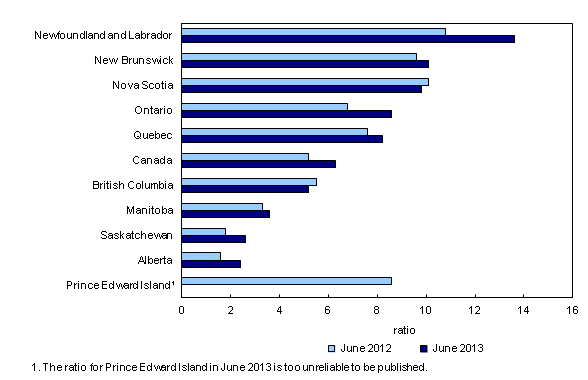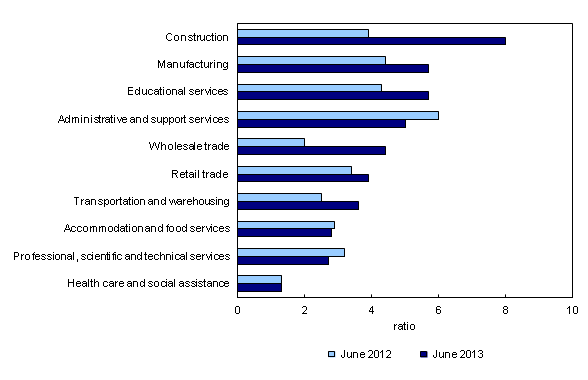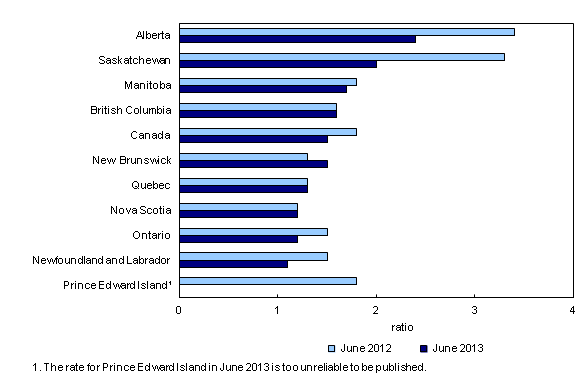Job vacancies, three-month average ending in June 2013
Archived Content
Information identified as archived is provided for reference, research or recordkeeping purposes. It is not subject to the Government of Canada Web Standards and has not been altered or updated since it was archived. Please "contact us" to request a format other than those available.
Released: 2013-09-17
Canadian businesses reported 216,000 job vacancies in June, down 47,000 from June 2012. For every job vacancy, there were 6.3 unemployed people, up from 5.2 a year earlier. The increase in the unemployment-to-job vacancies ratio was the result of fewer job vacancies, as the number of unemployed people was little changed.
Ratio increases in Ontario, Saskatchewan and Alberta
Provincially, Ontario had the most notable increase in the unemployment-to-job vacancies ratio, going from 6.8 unemployed people for every job vacancy in June 2012 to 8.6 in June 2013. The ratio increased because there were fewer job vacancies in the province, as the number of unemployed people was little changed.
Saskatchewan's unemployment-to-job vacancies ratio also went up, from 1.8 to 2.6, as the number of job vacancies fell faster than the number of unemployed.
The ratio in Alberta rose over this 12-month period from 1.6 unemployed people per job vacancy to 2.4. The increase in the ratio was due to fewer job vacancies, as the number of unemployed people was little changed.
Despite these increases, Saskatchewan and Alberta remained the provinces with the lowest unemployment-to-job vacancy ratios.
In the remaining provinces, the unemployment-to-job vacancy ratios were little changed compared with June 2012.
Ratio by sector
Among the large industrial sectors, construction had the highest number of unemployed people per vacancy, at 8.0 in June, up from 3.9 in June 2012. The entire increase was the result of fewer job vacancies in this sector.
The ratio in wholesale trade rose from 2.0 in June 2012 to 4.4 in June 2013. The increase occurred as the number of unemployed went up, while job vacancies declined notably.
Manufacturing had a ratio of 5.7 unemployed people for every vacant job in June, up from 4.4 a year earlier, as there were fewer vacancies in this sector.
The ratio in transportation and warehousing increased from 2.5 in June 2012 to 3.6 in June 2013.
The unemployment-to-job vacancy ratio in health care and social assistance was 1.3 in June, the lowest of all industrial sectors. This ratio was unchanged from 12 months earlier. There was little change among the other large industrial sectors.
Among the smaller industrial sectors, regional and Aboriginal public administration as well as "other services" saw an increase in their ratio over the 12-month period, as they both posted an increase in the number of unemployed and little change in job vacancies.
Job vacancy rates
The job vacancy rate is defined as the number of vacant positions divided by total labour demand, that is, occupied positions plus vacant positions. It corresponds to the share of jobs that are unfilled out of all payroll jobs available. Higher job vacancy rates are often associated with periods of economic growth, while lower rates may be associated with periods of slower growth or economic contraction.
In June, the national job vacancy rate among Canadian businesses was 1.5%, down from 1.8% a year earlier.
Provincially, the job vacancy rate declined in Alberta, Saskatchewan, Ontario and Newfoundland and Labrador, while it was little changed elsewhere.
In Alberta, the rate fell from 3.4% to 2.4% between June 2012 and June 2013. Over the same period, the job vacancy rate declined from 3.3% to 2.0% in Saskatchewan, from 1.5% to 1.2% in Ontario, and from 1.5% to 1.1% in Newfoundland and Labrador.
Job vacancy rates by sector
Compared with 12 months earlier, the job vacancy rate declined in six sectors and was little changed in the other sectors.
Construction had 13,000 job vacancies and a job vacancy rate of 1.4% in June, down from 3.0% in June 2012. Retail trade also saw its rate decline from 1.8% to 1.4% over the same period. The sector had 26,000 job vacancies in June 2013.
The job vacancy rate in manufacturing fell from 1.3% to 1.1% in the 12-month period, with 17,000 job vacancies in June 2013. Wholesale trade saw its rate decline from 1.7% to 1.0%, with 7,300 vacancies. The vacancy rate in finance and insurance fell from 1.4% to 0.9%, with 6,400 vacancies.
The lowest job vacancy rate was recorded in educational services, at 0.5%, down from 0.7% a year earlier. In June 2013, there were 5,700 job vacancies in this sector.
Note to readers
Estimates of job vacancies are collected through the monthly Business Payrolls Survey (BPS). Starting with the January 2011 reference month, two questions were added to the BPS, which is the survey portion of the Survey of Employment, Payrolls and Hours. These questions were: Did you have any vacant positions on the last business day of the month, and how many?
The target population is the same as that of the BPS and is comprised of all employers in Canada, except those primarily involved in: agriculture; fishing and trapping; private household services; religious organizations; the military personnel of defense services; and federal, provincial and territorial public administration.
With each release, estimates for the current reference month are subject to revision. Estimates have been revised for the previous month. Users are encouraged to request and use the most up-to-date estimates for each month.
Data quality
Job vacancy and unemployment estimates are based on samples, and are therefore subject to sampling variability. Estimates for geographic areas and industries with smaller numbers of vacancies or smaller unemployed populations are subject to greater sampling variability.
Job vacancy, labour demand and unemployment estimates and their accompanying rates are not seasonally adjusted and should only be compared on a year-over-year basis. Given this is a new data series, trends are not yet available and therefore, data should be interpreted with caution.
All estimates are based on three-month moving averages. For example, estimates for the current month are based on an average of the estimates from the current month and the previous two months.
Definitions
Job vacancy / vacant position: A position is considered "vacant" if it meets all three of the following conditions: a specific position exists; work could start within 30 days; and the employer is actively seeking employees from outside the organization to fill the position.
Labour demand: Total labour demand is the sum of met (total payroll employment) and unmet (vacant positions) labour demand.
Largest industrial sectors: The sectors with the largest levels of payroll employment for which we have publishable job vacancy data.
Job vacancy rate: The number of vacant positions divided by total labour demand, that is, occupied positions plus vacant positions.
Unemployment-to-job vacancies ratios
All unemployed: The unemployment-to-job vacancies ratio for all unemployed is calculated by dividing the total number of unemployed, regardless of their previous work experience, using Labour Force Survey (LFS) data, by the number of vacant positions. This ratio reflects how many unemployed individuals are available for each vacant position and is a measure of the overall labour market tightness.
By sector: For each sector, the ratio is calculated by dividing the number of unemployed who last worked in that sector in the previous 12 months, using LFS data, by the number of vacant positions in the same sector. This excludes new entrants to the labour market as well as unemployed people who had not worked during the previous 12 months. Unemployment data by sector is known only for those who worked within the previous 12 months.
Use of estimates for the last sector worked does not imply that these unemployed individuals continued to look for work in that sector. This ratio reflects how many unemployed individuals who last worked in that sector are available for each vacant position in the sector. It is a measure of the labour market tightness within that sector.
The next job vacancies release, for July, will be on October 22.
Contact information
For more information, contact us (toll-free 1-800-263-1136; 514-283-8300; infostats@statcan.gc.ca).
To enquire about the concepts, methods or data quality of this release, contact Jason Gilmore (613-951-7118; jason.gilmore@statcan.gc.ca), Labour Statistics Division.
- Date modified:




